TVU Nano Router (5G) Model RD300 Setup and User Guide

Product overview
TVU Nano Router 5G is the new generation of nano router with three built-in 5G cellular modems and an internal battery in a 1U chassis. Its small size is perfect for field staff, broadcast trucks, and mobile receiver transmission solutions. In addition, the 5G router provides high-performance, highly reliable network aggregation transmission supported by cutting-edge aggregating technology.
The Nano router has a two Gbps-Ethernet interface, 1 USB interface, and a WiFi module. It can be connected to satellite, microwave, WiFi, and Ethernet, providing customers with a stable Internet access capability of up to 200 Mbps bandwidth.
The TVU 5G Nano Router adopts Inverse StatMux Plus (IS+) technology, which can realize reliable network transmission even in the most challenging transmission environment (such as fast-moving vehicles). As a result, when a single network connection is interrupted or bandwidth fluctuates, the overall
network bandwidth and quality will not be affected, and the video stream and various network applications running on the router will not be interrupted.
Features overview
The TVU Nano Router has a small, lightweight, and robust hardware design and functions to fit the needs of any live broadcaster. The built-in battery allows field staff to transport the router on location and is easily installed into a standard rack inside a vehicle or control room.
The TVU Nano Router supports simultaneous connections to multiple networks, including mobile cellular networks, satellite, microwave, WiFi, and Ethernet. The TVU Nano Router runs on the TVU platform and includes the following functions and features:
- Simple Worry-Free Operation: TVU pioneered one-button operation in portable live video streaming transmitters, and TVU Nano Router carries that tradition. TVU Nano Router can be configured in the field and boots up in less than 35 seconds with a push of a button.
- Small Form Factor, Big Features: TVU Nano Router’s industrial design and compact metal enclosure provides high reliability. Its ultra-portable weight and size make it the perfect device for on-the-go and anywhere live video broadcasts.
- Inverse StatMux Plus: TVU Nano Router features proprietary video transmission technology called Inverse StatMux Plus (IS+). TVU’s patented algorithm allows for uninterrupted, reliable transmissions by aggregating multiple connection links, including cellular, WiFi, Ethernet, satellite, and microwave.
- Power source: The TVU Nano Router has a single, rechargeable Li-ion internal battery and a 2A 12V DC power adapter. The internal battery run time supports 3.5 hours of working and 5.5 hours of standby power.
- External Hotspot antennas: The TVU Nano Router can be configured using the TVU Router Hotspot antennas and the Web user interface. The TVU Router configuration interface can be accessed using a standard web browser.
- LAN Support: Ethernet (RJ-45, 2 GbE connections) and WiFi Hotspot (WAP, 802.1 1b/g/n/ac, 2.4 GHz / 5 GHz.
- Supported WAN connections: Simultaneously aggregates up to 6 data connections, including WiFi and Ethernet. System supports 3 micro sims (3ff) cellular 3G/4G/5G LTE modems, 2.4 GHz / 5 GHz WiFi, WiMax, Ethernet, Microwave and KaBand, KuBand, Mesh, and BGAN satellite connections.
- High-speed Internet access: Multiple available links can be aggregated, including 3 built-in 4G/5G modules, 1 external 2.0 USB module, 1 network cable, and 1 WiFi.
About this guide
This user guide provides detailed information about the following topics:
- Important safety guidelines
- TVU Nano Router components
- Hardware installation and connections
- Setting up the TVU Nano Router
- Advanced operations
- Product specifications
Guide contents
Completing the steps in the TVU Nano Router User guide will show you how to:
- Charge the TVU Nano Router battery
- Set up the TVU Nano router hardware and connections
- Perform Network connections
- Configure the TVU Nano Router using the Web interface
- Explain how to perform Advanced settings
Before you begin
Before you begin setting up the TVU Nano Router, it is recommended that you identify the devices you intend to use with the unit, including cables, power sources, modems, and unit components.
Read and follow the notices in this guide before you use your TVU Nano Router.
TVU Nano router 5G kit
The TVU Nano router 5G kit comes with the following components:
- 1x Nano router device
- 12x 4G/5G antennas
- 4x WiFi frequency antennas
- 3x Built-in 4G/5G modules
- 1x WiFi hotspot
- 2x Ethernet (LAN) ports
- 1x External USB module
- 1x Network cable
- Power supply and 1x 1.2m power cable
- Carrying case
- 1U rack tray (optional)
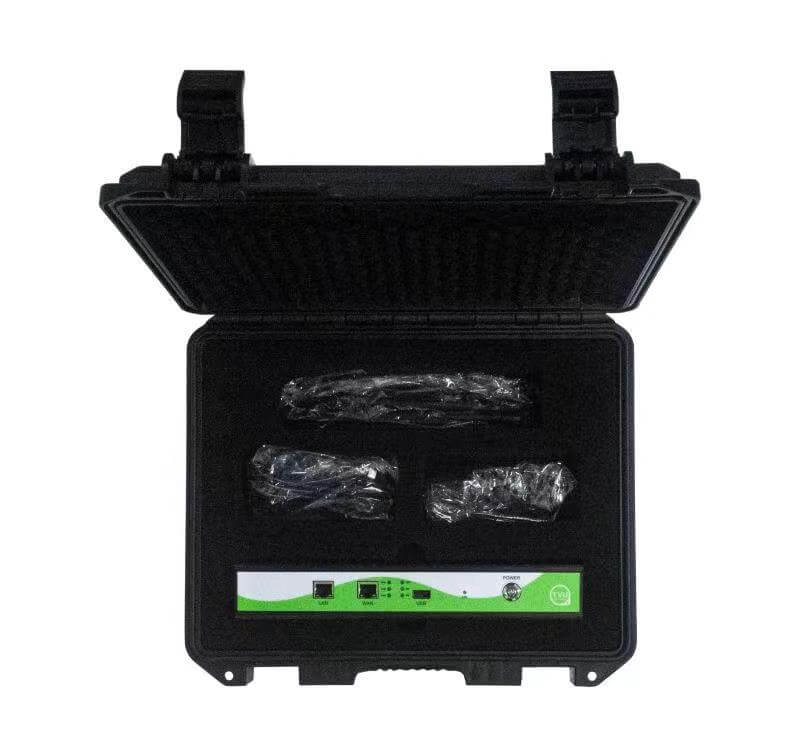
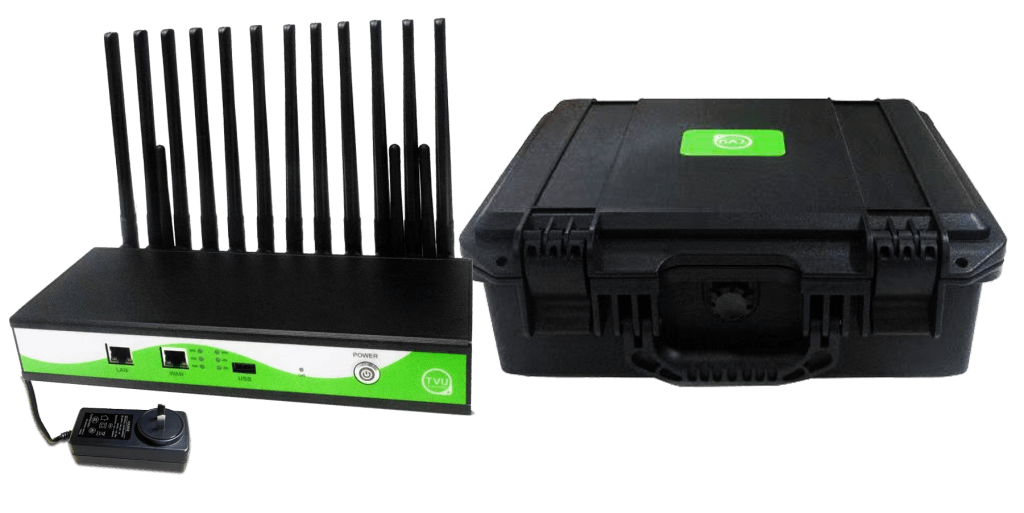
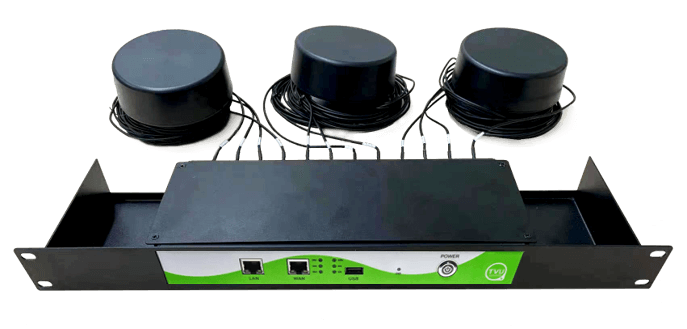
Note: The Ethernet connector is not included and must be customer supplied.
Front panel components
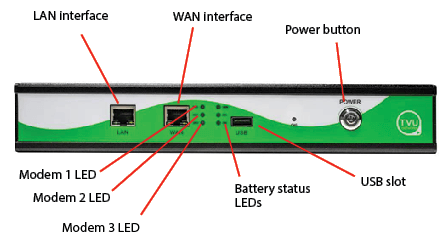
The TVU Nano router front panel features the following components.
The front panel components and functions are as follows:
Battery status LED – Battery status indicator:
- Displays the percentage of remaining battery capacity at 100%, 60%, or 20%.
SIM indicator LEDs – SIM card LEDs 1, 2, and 3 display embedded cellular modem status indicators:
- When the indicator is not flashing, the SIM card is ready.
- When the indicator is flashing, there is wireless traffic.
- When the indicator is off, there is no wireless traffic.
LAN interface – Can be changed to WAN and aggregated:
- DHCP is open by default.
WAN interface – Can be changed manually to LAN to enable more visitors.
USB interface – Supports a USB wireless modem or USB to Ethernet.
Power button – To release the power button, press the power button to power ON the Nano:
- Press the power button for 5 seconds to Power off the Nano.
- Press the power button for 10 seconds to shut down the nano.
Rear panel components
The TVU Nano router rear panel includes the following components and functions.
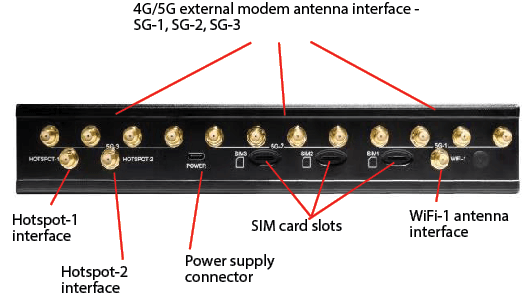
The rear panel components are as follows:
3x-5G Modem board SIM slots – Nano SIM cards:
- From right to left: SIM1, SIM2, and SIM3
- All three modems support the 5G network
External modem antenna interface – SG-1, SG-2, and SG-3 4-pin:
- The 4-pin antenna’s shipped with the router are full frequency and can be connected to any antenna.
- If you use a narrow frequency antenna with a different pin configuration, connect the antenna from left to right (i.e.) LMH, MH, LMH, and MH.
WiFi antenna (1x) – Used for an external WiFi signal to aggregate bandwidth:
- The WiFi-1 and WiFi-2 correspond to the WiFi-2 antenna.
- The WiFi antenna can also be used for the hotspot.
Hotspot antenna (2x) – Used to enable the routers hotspot:
- For hotspot-1 and hotspot-2, use two antennas.
- Set to 2.4 GHz by default.
Charging the TVU Nano Router battery
To charge the internal battery complete the following steps:
- Connect the provided power supply to the Power input on the unit’s rear panel.
- Attach the other end of the connector to the electrical power outlet.
- The battery charge indicator LEDs display a percentage of battery capacity on the front panel at 100%, 60%, and 20%.
Note: Charging time will take approximately 1 hour. It is recommended that the Nano is powered off when charging the battery. The battery status LEDs display the percentage of remaining capacity on the front panel.
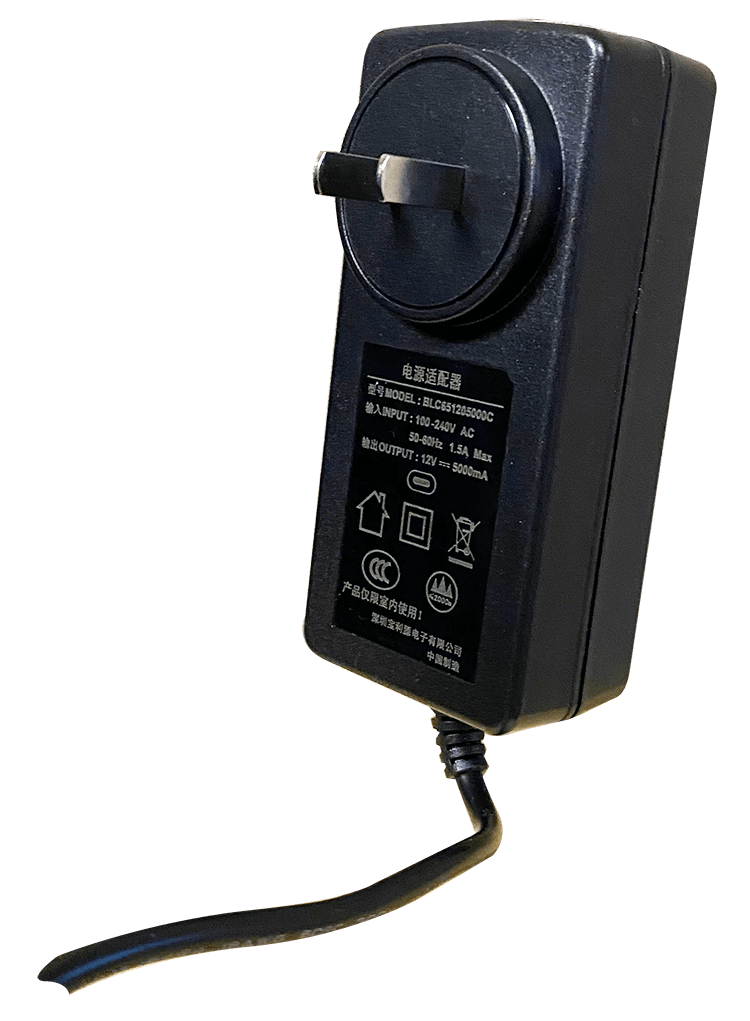
Hardware installation and connections
To set up the TVU Nano router, complete the following steps:
SIM card installation and removal:
- Insert a Micro SIM card (3ff) into the card slots SIM-1, SIM-2, and SIM-3 in the orientation printed on the rear panel until they click into place.

- Press and release the power button to turn On the Nano. After waiting a few seconds, other status indicators will light up.
Note: To eject a SIM card from the slot, press the power button in for 5 seconds to power off the router. Use a small rigid instrument to press the card in then, the card will pop out of the slot.
Ethernet cable connection:
- The nano router has two network card interfaces, the LAN port, which is DHCP-ready, and the WAN port, the default port.
- The LAN port can connect external Ethernet cables to provide network connections for external devices.
- The router can aggregate the WAN port.
Note: You can also configure one or more of the ports as LAN network ports by going to the General settings >WAN IP page.
4G/5G antenna connections:
- Each antenna has 4 pins. Attach the 4G/5G antennas into the rear panel SG-1, SG-2, SG-3 interface according to the frequency used. Refer to the rear panel components section. It would be best to connect all the antennas for 5G operation.
4G/5G, WiFi, and hotspot antenna connections:
- On the rear panel, connect the WiFi antennas to WiFi-1 and WiFi-2.
- On the rear panel, connect the Hotspot antennas to Hotspot-1 and Hotspot-2.
Power supply connection:
- Use the power cable attached to the router to connect to the 220V power supply.
- Press the power button on the front panel to start the router.
- When the SIM card status indicator turns blue, the 4G/5G network is connected.
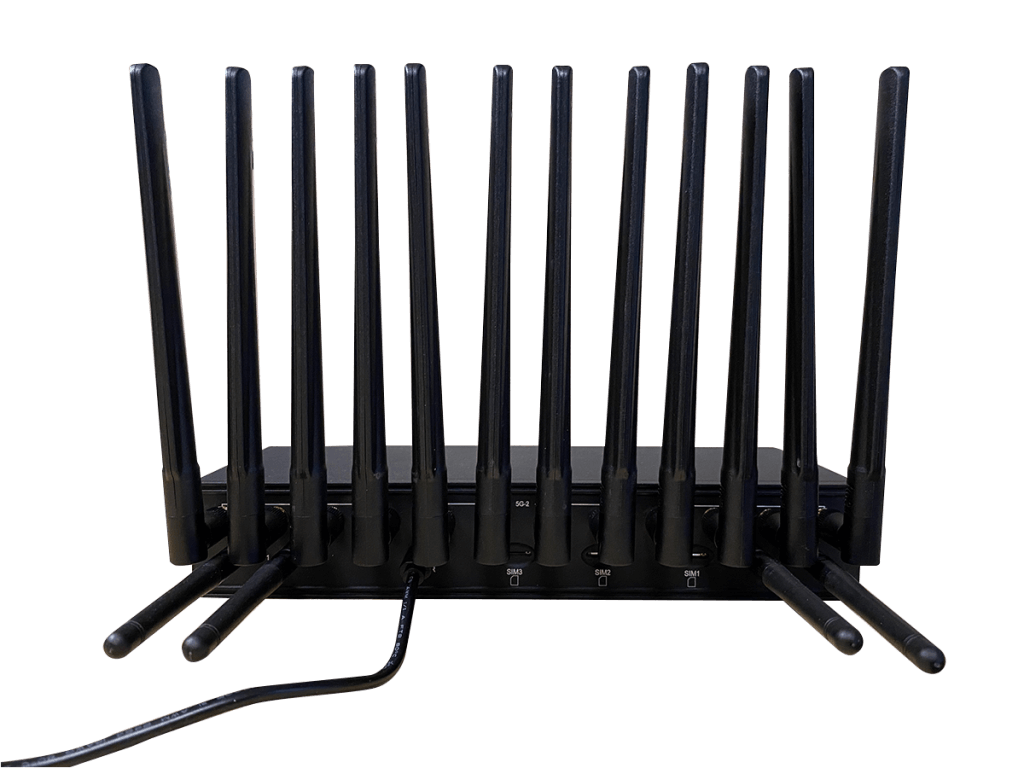
Network connection and configuration
You can use two methods to connect your PC or laptop to the Nano router: the hotspot and network card.
Hotspot connectivity (2.4 GHz by default):
To configure the TVU Nano Router using the Hotspot feature, complete the following steps:
- To join the TVU Nano Router internal Hotspot, search for the Hotspot on your smart device or PC.
- Enter the SSID: Router_XXXX
- (where x is the last four digits of the TVU Nano Router PID)
- Enter the default password and the last eight digits of the router PID (all characters must be entered in uppercase characters with no spaces).
Network card connectivity:
- Connect a 1 Gbps network cable to the Ethernet port on the router. Then, connect the other end of the network cable to your PC.
Note: your PC must be configured to automatically obtain IP mode.
- When the connection is established, the router automatically assigns an IP address to the PC. The IP range will be 192.168.4.x.
Product configuration
The TVU Nano Router can be configured using the TVU Nano Router Hotspot or Ethernet uplink and the Web User Interface.
The TVU Nano Router configuration interface can be accessed using a Chrome or Safari Web browser connected to the TVU Nano Router using one of the two methods described in “Network connection and configuration.”
Note: Both English and Chinese languages are supported on the Web configuration page.
To configure the Nano router, complete the following steps:
- Open a Web browser and go to http://192.168.4.1/.
- Enter the TVU Nano Router Web login page.
- To log in, enter the user name admin and password admin. The Web configuration page displays and contains three main modules; Home, General Settings, and Advanced Settings.

Home tab
Click the Home tab in the top navigation pane to view the device information and status:
- Current Time
- Device model
- Device Peer ID
- LAN IP Address
- CPU load
- CPU temperature
- Boot time
- The software version, Router Client, and Dial Module
- The duration of the connection to all servers


Network State
You can sort the information displayed on the Network State interface page by clicking the icon in the top right corner of the main navigation pane. The default order displayed is by Server IP. However, you can select Sort by Slot if desired.
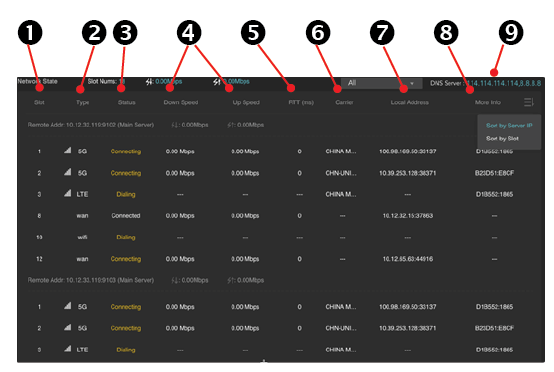
The Network State Web interface Sort by Slot page displays the following aggregation status by:
- Slot number with the connection. Slot mapping displays as follows:
- SIM1: Slot 1
- SIM2: Slot 2
- SIM3: Slot 3
- Slot4~Slot 7: reserved for future use
- USB: Slot 8
- HOTSPOT: Slot 9
- WiFi: Slot 10
- LAN: Slot 11
- WAN: Slot 12
- Total uplink and downlink bitrate
- Router server IP address, DNS server, and connection information
- All of the link’s status display:
(1) Slot: Displays the slot number.
(2) Type: Displays the network connection type for the SIM card (i.e., 2G, 3G, 4G, 5G, or WiFi and WAN). The signal strength icon displays the wireless signal for 2G, 3G, 4G, and 5G.
(3) Status: Displays the number of currently aggregated links and their Dialing, Connection, and Connected status:
- Dialing: After the SIM card is successfully inserted into the slot and the router is powered on, the router automatically dials. If dialing fails or the router is forced to find a stronger signal, it continues to dial until it’s successful.
- Connecting: Dialing is successful, and the router connects to the server.
- Connected: The server connection is complete.
(4) Down Speed/Up Speed: Displays the total uplink and downlink bitrate speeds:
- Down Speed: Displays real-time down speed in Mbps of the SIM card in the current slot.
- Up Speed: Displays real-time up speed in Mbps of the SIM card in the current slot.
(5) RTT (ms): Displays the real-time delay of the network connection from the router to the gateway.
(6) Carrier: Displays the carrier name (i.e., CMCC, CHN-UNICOM, and CHN-CT).
(7) Local Address: Displays the server’s IP address assigned to the router’s network connection. If desired, you can uncheck some servers to filter the data.
(8) More info: Displays the base station information for the SIM card connection.
(9) DNS Server: The DNS server is currently in use.
Important notes:
- When the Router has upload and download traffic, the corresponding single-channel network speed displays in the up-speed and down-speed columns. At the same time, the delay of the link will fluctuate. At the top of the list is the aggregated rate, the sum of all connection rates equal to the sum of all 4G/5G, WiFi, and WAN connections.
- The page will refresh automatically in about 2 seconds. Refresh the browser manually if you need to get the latest information more frequently.
Viewing connected devices
To view the MAC address and assigned IP address of a device connected to the router, refer to the connected device screen.

Note: Only the device that uses the router DHCP to assign the IP address is displayed.
General settings tab
To connect the router to a server in automatic or custom mode, complete the following steps:
Automatic mode:
- Click the General Settings tab at the top of the screen, then click Router Server.
- Select the server that you want to connect to the router. The router will automatically connect by default after a successful restart or boot.
- You can automatically allocate and adjust the router server by the system or manually select the designated gateway. Then, click Apply.
- After the server is successfully connected, the aggregation Internet service is provided.
Note: The default setting is Automatic mode. After the router is powered on, the server connection is automatic.
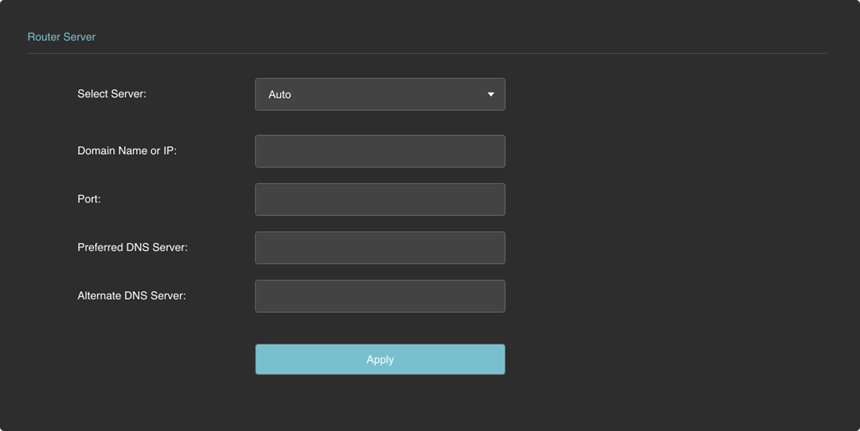
Custom mode:
- For a privately deployed router server, click the Select Server drop-down menu and select Custom manually specific mode. Then, enter the router gateway IP address and port to ensure the router gateway server is running.
- Enter the DNS address of the region to ensure that it is the correct Domain name resolution.
- When finished, click Apply.
Note: TVU currently supports connecting to multiple servers in this mode. You can change their priority order by dragging and dropping the icons into place.
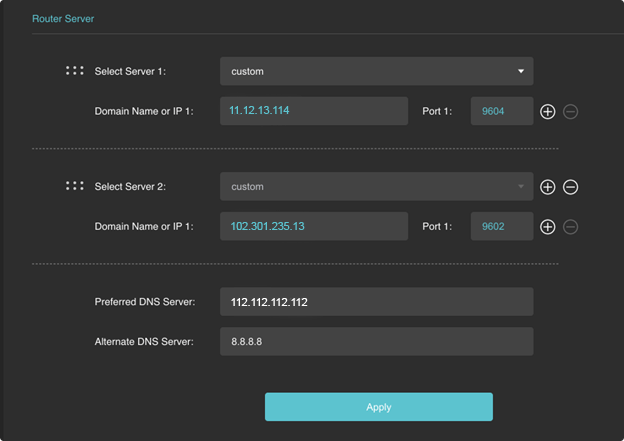
- A “Setting Success” message displays when connected, and the IP and Port text color changes to blue. The button at the bottom of the window displays “Connected.”
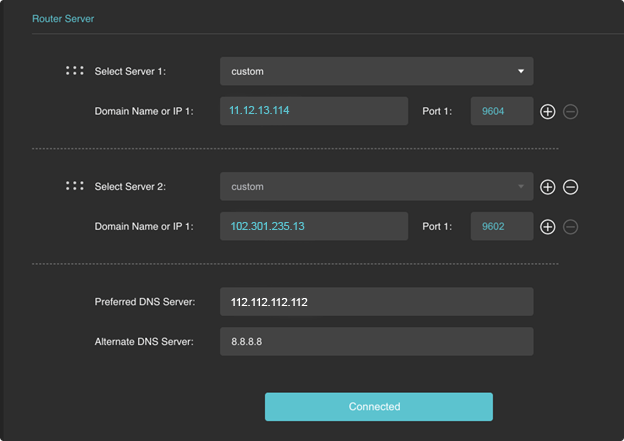
Note: When the server address is connected, it displays “Connected” on the Server State page.
- For each successfully dialed network device, the server has a connection. If you manually set the DNS, it is recommended that you set the preferred DNS to “8.8.8.8”. Make sure that modifying the DNS takes effect. Otherwise, it will cause a failure when accessing the Internet.
WAN and LAN settings
To switch the network port on the router to a Local-Area Network (LAN) or Wide-Area Network (WAN), complete the following steps:
- Click the General Settings tab and select WAN.
- Expand the desired Slot number menu.
- Move the router’s network Port Type slider to the Local Area Network (LAN) or Wide Area Network (WAN).
- If you switch to the WAN, you can choose the IP acquisition method as static IP or DHCP (the WAN port IP acquisition method), MAC address, IP address, mask, gateway, etc.
- If you switch to the LAN, the unified built-in DHCP service works, which can be configured in the Advanced Settings tab.
- When finished, click the Save button.
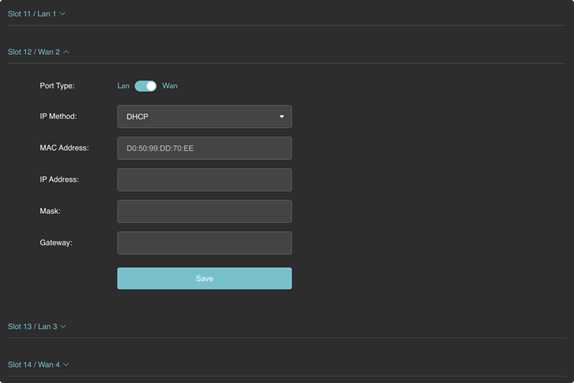
Hotspot configuration
External devices can be connected to the router’s hotspot to access an Internet connection easily. To access and modify the TVU Nano Router Hotspot configuration settings, complete the following steps:
- Click the General Settings tab and select Hotspot.
- Enter the Hotspot Name.
- Enter the Password.
- Select the hotspot band (2.4G/5G).
- Click Save.
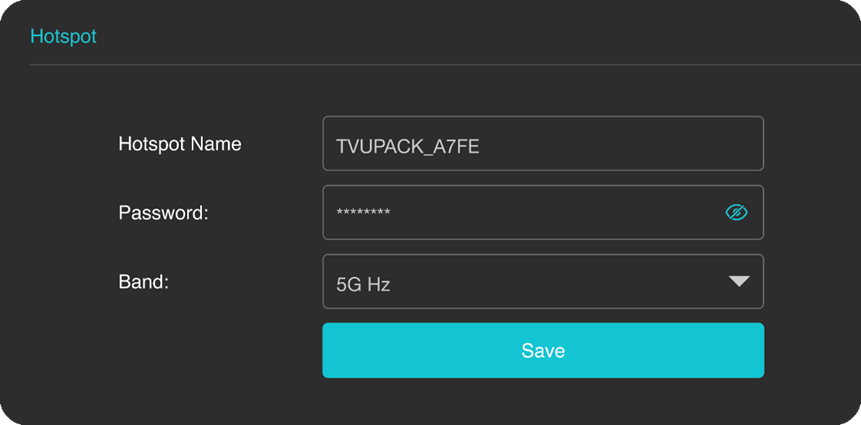
WiFi configuration
External WiFi hotspots can be connected to increase the router’s aggregated bandwidth.
To access and modify the TVU Nano Router WiFi configuration settings, complete the following steps:
- Click the General Settings tab and select WiFi.
- In the WiFi screen, choose a Network from the list.
- Enter the Password and click the Connect button.
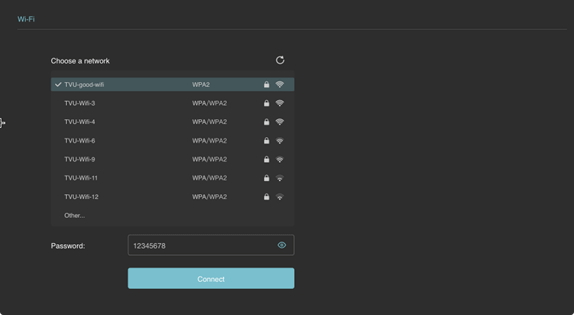
Intelligent Speed Limit
The Intelligent Speed Limit feature enables you to set the device’s maximum upload and download speed, priority of a single card, maximum upload, and download speed.
To configure the Intelligent Speed limit settings, complete the following steps:
- Click the General Settings tab and select Intelligent Speed Limit.
Note: The default setting is unlimited and displays as“0”.
- To change the bandwidth unit, click the Kb/s drop-down menu in the window’s top-right corner.
- Click the Setting button at the bottom of the screen to:
- Set the maximum download and upload rate of the aggregated bandwidth of the device.
- Use the priority of a single card and the maximum download and upload speed of a single card.
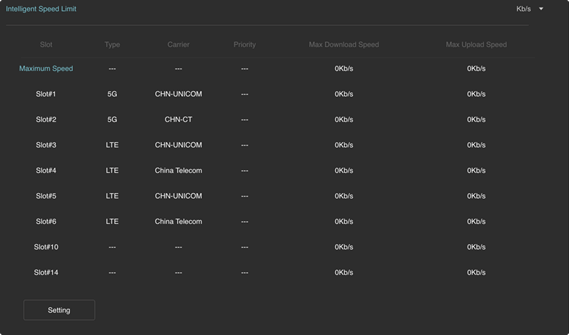
Note: Setting a higher priority value in the Priority column, the more priority it is given during use; the rate unit displays according to the unit selected in the Kb/s drop-down menu in the top-right corner of the window.
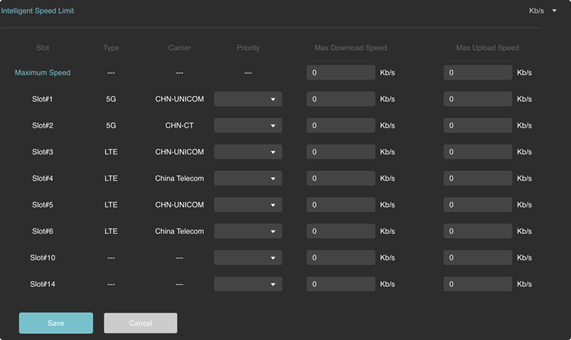
- Click the Save button to save your changes.
Note that when setting the priority of multiple cards, the product will automatically select and allocate the bandwidth usage. A low-priority network link is used by default when all high-priority links cannot meet the bandwidth requirements.
Advanced Settings tab
The Advanced Settings tab allows you to access and configure Advanced operations such as:
- LAN IP and mask settings
- P2P interconnections
- Modem parameters
- Transparent mode transmissions
LAN settings
To set the IP address and mask of the router, complete the following steps:
- Click the Advanced Settings tab and select LAN Settings. The LAN window opens.
- In the IP field, the default display is the fixed network IP address 192.168.4.1 of the aggregation router.
- Enter the Subnet mask in the range of 1-32.
- Click the Save button when finished.
- For external devices that are connected to the router using a network cable, the IP allocation method uses DHCP by default. As the IP address and mask of the router change, the address assigned to the devices will also change.
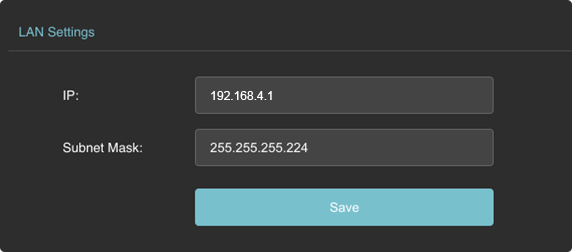
P2P settings
The P2P function is used in typical applications to interconnect between a device connected to the router and the device under the aggregation gateway server. To learn more about enabling and using the P2P function, refer to “Typical applications – P2P function.”
Modem configuration
General mobile phone SIM cards and IoT cards have default configurations, which need to be modified under special circumstances.
To set the parameters of the mobile SIM card for internet access, complete the following steps:
- Click the Advanced Settings tab and select Modems. The Modems window opens.
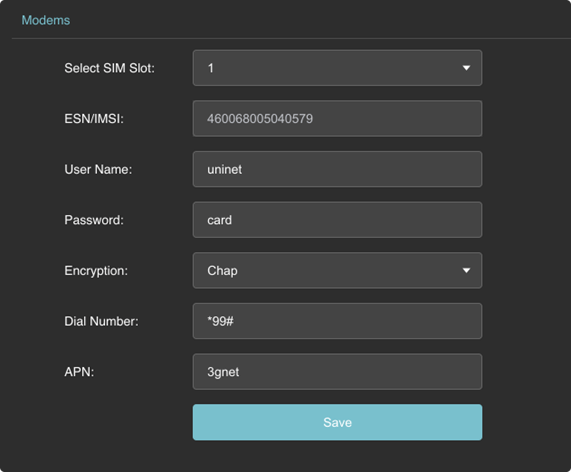
- In the Select SIM Slot drop-down menu, select the SIM slot number.
- Enter the appropriate field information for each SIM slot and click Save.
Transparent Mode
The Transparent Mode feature lets you transmit to a destination IP and Source IP transparently. When this feature is enabled, the IPs display as “0.0.0.0/0”. This function is disabled by default.
To use the Transparent Mode feature, complete the steps in the following example:
- Click the Advanced Settings tab and select Transparent Mode. The Transparent Mode window opens.
- Enter the Destination IP and Source IP. When using multiple addresses, they must be separated with a comma “,”.
- To enable the Transparent Mode, move the Transparent Mode slider to the right until it turns blue. Then, click Save.
Three types of address ranges are supported, including P2P settings. Supported address ranges are:
- Address segment – for example, 192.168.4.1-192.168.4.32
- Mask form – for example, 192.168.3.0/27
- Single address – for example, 192.168.100.100
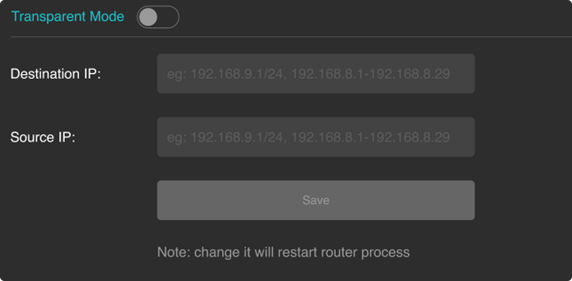
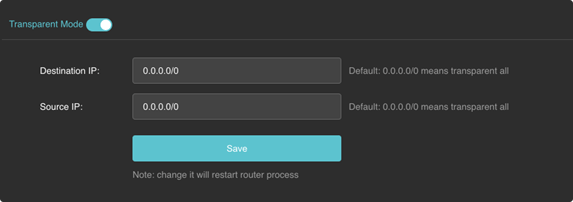
Typical applications – P2P function management
This section describes how the P2P function configures interconnection between devices and routers using the same aggregation gateway.
The following shows two typical application scenario examples:
Scenario 1: P2P interconnection between the device connected to the Router and under the aggregation gateway server.
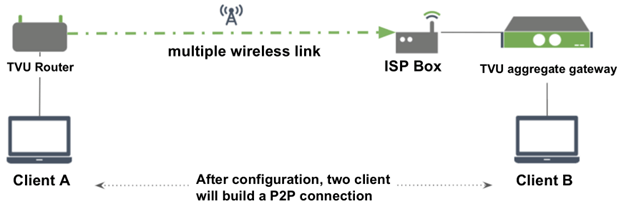
Client A configures the Router:
- 192.168.4.*/24 (keep consistent with advanced settings and LAN settings)
- Open P2P (configure the IP Range parameters and restart the router process without restarting the entire machine)
Client B configures the aggregation gateway server:
- 192.168.5.*/24
- Open P2P (configure the IP Range parameters and restart the router process without restarting the entire machine)
Scenario 2: P2P interconnection between devices connected to 2 routers under the same aggregation gateway server.
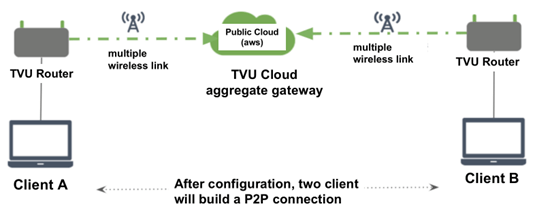
Client A configures the Router:
- 192.168.4.*/24
- Open P2P (configure IP range parameters and restart the router process without restarting the entire machine)
Client B configures the Router:
- 192.168.5.*/24
- Open P2P (configure IP range parameters and restart the router process without restarting the entire machine)
P2P Configuration interface
To enter the P2P configuration interface, complete the following steps:
- Click the Advanced Settings tab and select P2P Settings. The P2P Support window opens. The P2P function is closed by default.
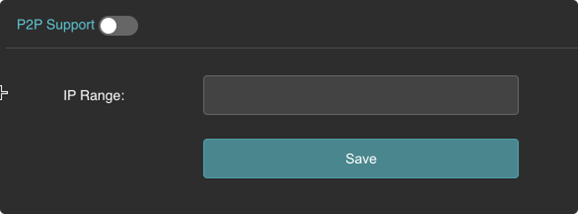
- Enter an IP Range in the provided field. If you have set the IP Range before, open it again to verify the range and apply it by clicking Save.
- Otherwise, you can enter the IP network segment range where the connected device is located. It supports the two input methods of “IP/mask” and specific IP range as shown in the following figure. Add a “,” to separate the different IP ranges.
- To enable P2P, move the slider to the right until it turns blue. Then, click Save to save the settings.
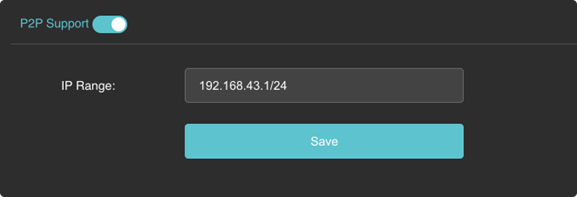
Note: The IPs of the devices at both ends cannot be exactly the same. Enabling/disabling/modifying P2P settings will interrupt the network for about 2 seconds.
NAT/No NAT server switching support
When the router server is installed, it is configured by the TVU support team.
Horizontal expansion and remote backup server support
When the Auto mode is selected on the aggregation gateway server setting page, the aggregation gateway that cooperates with the router will automatically and intelligently select and allocate the cloud scheduling service. At this time, the aggregation service can automatically support expansion and remote backup.
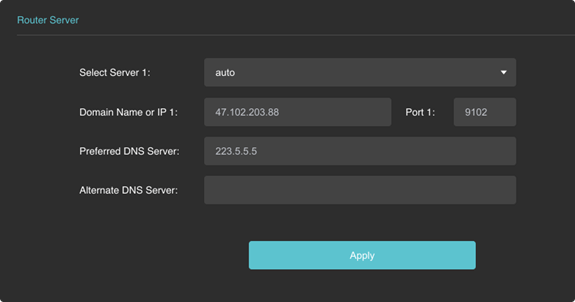
Smooth expansion
When the number of router users increases, the aggregation gateway deployed in the cloud can smoothly expand. Then, the newly opened aggregation router is automatically assigned to the newly opened aggregation gateway.
Remote backup
If the gateway device serving the router fails, it will automatically switch to other available aggregation gateways to ensure the uninterrupted operation of aggregation services.
Turning the Nano Off
After use, complete the following steps to turn the Nano Off:
- To turn the nano router off when the nano is running in normal mode, press and hold the power button for 5 seconds, then release the button. The device shuts down normally when the indicator light is no longer illuminated.
- The device may experience an unknown status when running, such as being unable to view the Web interface or the battery having too much capacity. If this occurs, press and hold the power button for 10 seconds to shut down the nano router immediately.
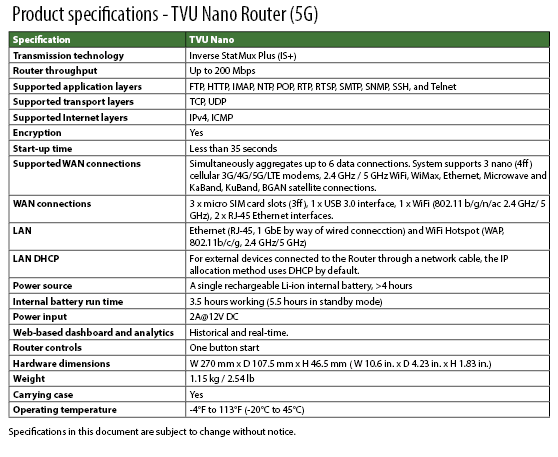
© Copyright 2024 TVU Networks Corporation. All rights reserved in all media.
Document Part Number: TVU Nano Router 5G Setup and User Guide Rev D EN 05-2024